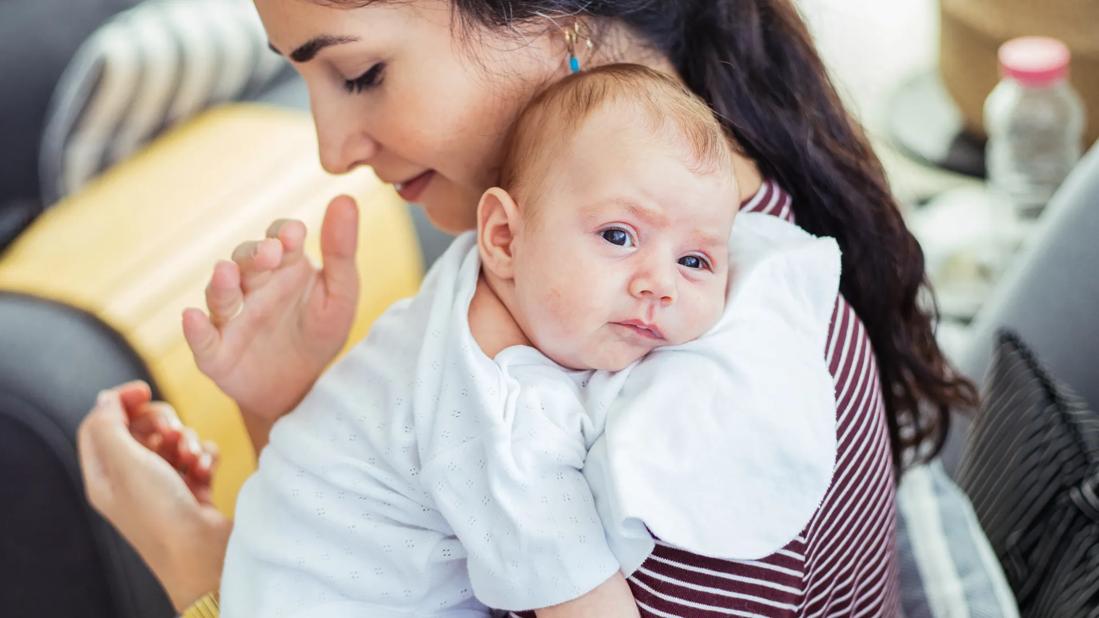Try to burp your baby mid-feed and after they finish eating — but don’t sweat it if they don’t burp

Babies are just the cutest, aren’t they? Everything from their sweet little toes to their adorable little snores can be a thing of beauty. And those baby burps? Surprisingly satisfying — both for you and them.
Advertisement
Cleveland Clinic is a non-profit academic medical center. Advertising on our site helps support our mission. We do not endorse non-Cleveland Clinic products or services. Policy
But sometimes, they need a hand getting a good burp out. How do you know when they need you? And what’s the best burping position?
Pediatrician Amy Sniderman, MD, shares advice for how to burp your baby.
There’s no “right” way to burp a baby. But some techniques can be more effective than others.
Consider these best practices and useful tips:
Here are three burp positions to try:
For little babies who can’t yet hold their heads up on their own, this seated burping position allows you to help with head support.
Advertisement
This position uses your shoulder to add a bit of pressure to your baby’s belly to help them burp.
If your baby hasn’t yet mastered head control, you can adjust this position to help support their noggin. Hold them with their head turned to one side and resting against your chest.
Perhaps less common but potentially effective, you can burp your baby lying down on your lap.
“The idea is that their belly should be in contact with your leg to put pressure on their belly and get the gas moving,” Dr. Sniderman explains.
Most babies benefit from being burped from their first days in the world through about the 9-month mark. Needing an occasional burp up through their first birthday is still quite normal, too.
Dr. Sniderman recommends burping a baby at least two times per feeding:
“Babies can swallow air when they’re drinking. Air means gas, and gas can make babies uncomfortable and cranky,” Dr. Sniderman notes. “They’re not as good at clearing gas themselves, so it’s normal that they might need a little assistance.”
A baby who’s ready for a burp might show signs like:
“If you lie your baby down after a feed and they start crying pretty quickly, it might be a sign that they need to burp again,” she adds.
Not all babies are going to burp at every feeding every time. So, if it’s not happening, move along.
“I recommend burping your baby for just a minute or two max,” Dr. Sniderman says. “If they burp right away, great. But if they haven’t burped after about two minutes, they’re probably not going to.”
The longer you spend trying to burp them, the more opportunities can arise for frustration on both sides.
Think about it: If your baby is mid-feed and you stop to burp them, they probably won’t love the interruption, especially if they aren’t feeling gassy. And the longer you wait to get back to mealtime, the more annoyed they may get.
Advertisement
What are they going to do? They’re going to beg you to bring back the food. They might cry and fuss and whine. And what happens when babies cry? They swallow more air ... and they get gassy.
So, even if they didn’t need to burp to begin with, now they do. And they’re hangry to boot.
Burping your baby is up there with changing, feeding and bathing them. It’s all part of keeping them healthy and happy.
If you’re concerned that gas is making your baby uncomfortable, or if they’re not gaining weight, talk with their pediatrician. And while spitting up is often OK, get in touch with a doctor right away if your baby:
They can check for reasons for spit-up and gassiness and offer tips for relief.
Advertisement
Learn more about our editorial process.
Advertisement

Adding extra formula, cereal or medications to your baby’s bottle is a dangerous and misguided practice

Teaching your baby to sign may help ease frustrations before they can talk, but it’s not a must-do

Babies can get congested easily, but you can calm their cough by keeping them hydrated, using nasal drops and running a humidifier

Most babies will recognize their name by about 9 months old

Clean your baby’s mouth with a washcloth or small toothbrush if they have a tooth or you suspect thrush

‘Social smiles’ typically start around 8 weeks old, while laughter comes later — around 4 to 6 months

Most infants can roll from tummy to back by 6 months old — but remember, every child develops at their own pace

Too much time in certain infant ‘containers’ can cause developmental delays and a flat spot on baby’s head

The best parenting style balances enforcing rules and showing plenty of love

Tips include cutting back on sugar, focusing on exercise and managing stress

It can be harder to let go when you’ve invested time, energy and emotions — but it might be the healthier choice long term